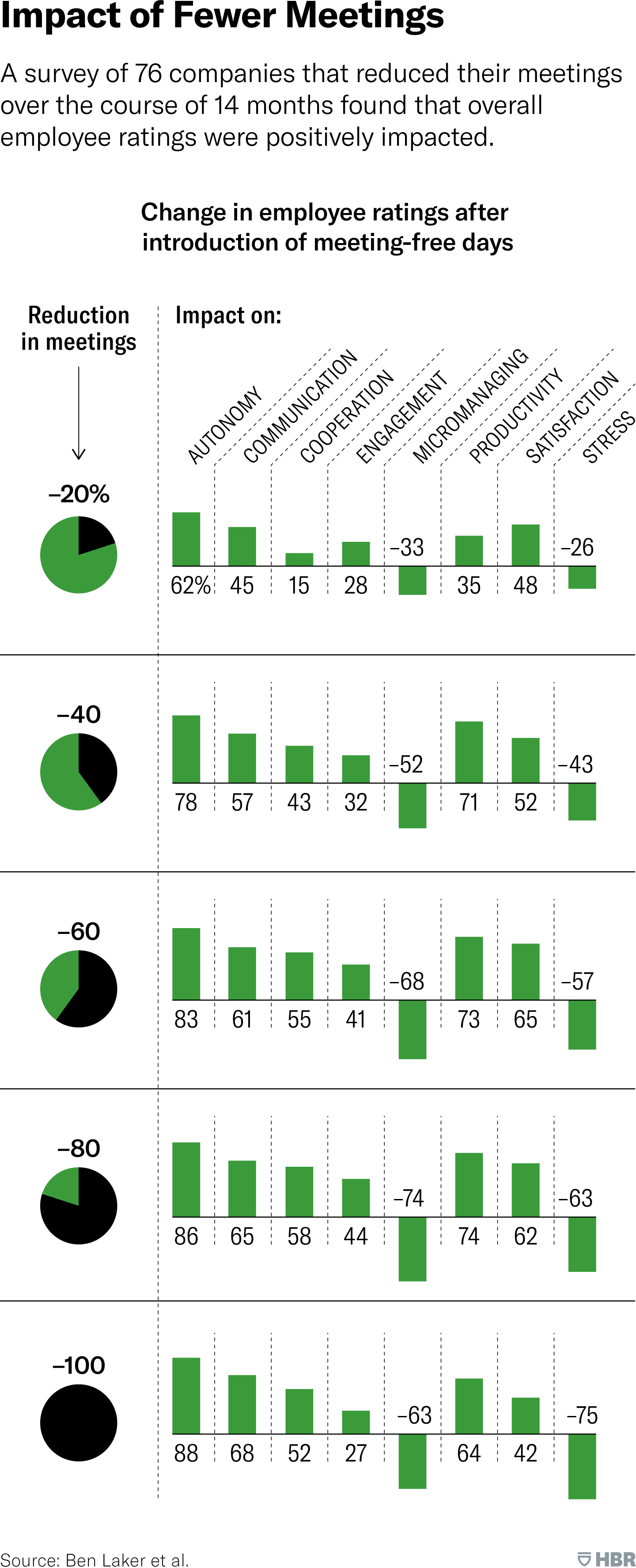Science behind meeting free days
Do you feel meeting fatigue? When was the last time you actually had a work day where there were no meetings scheduled? I had the pleasure of interviewing my special guest Vijay Pereira who is responsible for conducting the largest scientific study into the impact of having no meeting days.
Companies like Microsoft, Shopify, and others are already reaping the benefits of this approach, transforming how businesses operate. This article delves into the findings of the research, providing valuable insights for tech professionals and organisations alike.
Contents
The Problem with Excessive Meetings
Research Background
Research Methodology
Convincing Companies to Participate
Metrics Measured in the Study
Challenges During the Research Period
Transition Period Observations
Surprising Findings
Optimal Number of No-Meeting Days
Implementing No-Meeting Days
Impact of COVID-19 on the Study
Examples of Companies Adopting No-Meeting Days
Defining "No Contact" in Practice
Tips for Implementing No-Meeting Days
Pilot Program Recommendations
Addressing Resistance to Change
Customising No-Meeting Days by Department
Impact on Organisational Culture
Benefits of No-Meeting Days
Challenges of Implementing No-Meeting Days
Tools and Techniques for Successful Implementation
Measuring Success of No-Meeting Days
Long-Term Effects on Organisations
Industry-Specific Considerations
Global Implementation Challenges
Future of Work Implications
Leadership Role in No-Meeting Days Success
Employee Training for No-Meeting Days
Technology's Role in Facilitating No-Meeting Days
Case Studies of Successful Implementations
Addressing Common Concerns and Misconceptions
Integrating No-Meeting Days with Other Productivity Initiatives
The Future of Meetings in the Workplace
Resources for Further Learning
Call to Action for Organisations
📊 The Problem with Excessive Meetings
How often are professionals caught in a cycle of endless meetings that seemingly lead nowhere? Statistics reveal that employees can spend up to 85% of their time in meetings, a staggering figure considering the diminishing returns on productivity this practice yields. Unproductive meetings can drain time and resources, leading to burnout and poor work-life balance. Yet, organisations often fail to measure and review the impact of their meeting practices.
⚗️ Research Background
The concept of "no meeting days" originated from an accidental discovery at a conference in New Orleans that Viay and his peers attended. A casual discussion led to an intriguing question: how productive are these meetings, and when did meetings become integral to corporate culture?
Upon returning to their respective organisations, Viay and his colleagues conducted preliminary calculations. It quickly became apparent that without solid evidence, any claims regarding the negative impact of meetings would be speculative. Thus began a dedicated effort to gather robust evidence.
🔍 Research Methodology
To ensure validity, the research adopted stringent criteria for participating companies:
Must operate in more than 10 countries.
Have at least 1,000 employees on the payroll.
Commit to 1-5 no-meeting days for a minimum of one year.
Seventy-six companies, accounting for 25,000 employees, met these conditions. Researchers measured variables before and after the implementation to gain comprehensive insights.
🏢 Convincing Companies to Participate
Convincing businesses to participate wasn't straightforward. Concerns ranged from scepticism to outright scepticism about productivity benefits. By articulating the potential positive impact on both performance and the bottom line, researchers managed to win over these organisations. Key to this was emphasising measurable benefits and addressing fears about potential downsides.
📏 Metrics Measured in the Study
To paint a full picture, various metrics were evaluated:
Autonomy: Employees' perceived freedom to manage their time and tasks.
Communication: The quality and frequency of workplace communication.
Cooperation: Levels of collaboration and teamwork.
Engagement: Employee motivation and involvement.
Productivity: Output and efficiency.
Job Satisfaction: Overall contentment with work.
Micromanagement Levels: Incidences of intense oversight.
Stress Levels: Workplace stress and its impact.
🛠️ Challenges During the Research Period
Introducing no-meeting days was met with resistance. Initial misuse of time, such as sleeping in or non-work activities, was observed. Managers, wary of productivity declines, voiced concerns. Over time, people adjusted to the newfound autonomy, and practical concerns were mitigated. This transition period was crucial for the success of the initiative.
🌱 Transition Period Observations
Interestingly, employees gradually learned to manage their time effectively. Improved meeting hygiene—preparing for fewer, more focused meetings—became apparent. Autonomy fostered a creative environment as employees found their own sweet spots for productivity.
⚡ Surprising Findings
One standout finding was younger employees' inclination towards more meetings, contrary to assumptions. Newer staff often saw meetings as opportunities to prove their worth and gain visibility. This eagerness, however, led to increased burnout risks, highlighting a need for balanced meeting cultures.
🎯 Optimal Number of No-Meeting Days
Research indicates three no-meeting days per week as the optimal number, balancing between structure and freedom. One-day no-meetings accounted for 20% of the week, two days for 40%, and three for 60%, leaving adequate time for both focused work and necessary meetings.
📅 Implementing No-Meeting Days
Deciding whether to spread no-meeting days throughout the week or to clump them together depends on the organisation's needs. Engaging employees in the planning process is paramount, ensuring schedules align with personal and professional demands.
🌐 Impact of COVID-19 on the Study
The study coincided with the onset of COVID-19, providing a unique split between pre- and post-pandemic contexts. Shift from physical to online meetings underscored the need for structured no-meeting days, even in remote working settings. Family dynamics and bandwidth limitations became significant considerations.
🏢 Examples of Companies Adopting No-Meeting Days
Shopify: Has implemented 1-2 no-meeting days weekly, seeing this as sufficient for maintaining productivity without sacrificing necessary collaboration.
Microsoft and Amazon: Both have also incorporated these strategies, evidencing the appeal to tech giants.
🙌 Defining "No Contact" in Practice
While formal meetings were restricted, informal interactions were permissible, fostering a relaxed yet focused work atmosphere. Emergencies were handled with flexibility, but the core principle remained.
💡 Tips for Implementing No-Meeting Days
Review existing research: Utilise reports and articles showcasing evidence of benefits.
Present to leadership: Emphasise potential productivity gains and reduced burnout.
Highlight employee well-being: Stress the importance of work-life balance in retention and satisfaction.
📝 Pilot Program Recommendations
To truly assess the impact, a minimum six-month pilot is recommended. This period allows for initial resistance to subside and new routines to take hold. Phased implementation can also ease the transition.
🚀 Addressing Resistance to Change
Long-standing meeting cultures can be challenging to alter. Leaders must support the initiative by demonstrating trust and providing clear guidelines. Evidence-based approaches can also play a pivotal role in winning over sceptics.
📊 Customising No-Meeting Days by Department
Different departments have varying needs. Sales teams, for example, may need more frequent meetings. Tailoring the approach ensures effectiveness while respecting departmental workflows.
🤝 Impact on Organisational Culture
No-meeting days can transform communication patterns, increase autonomy, and foster a culture of trust. When employees feel empowered, overall engagement and productivity typically rise.
🛠️ Tools and Techniques for Successful Implementation
Effective calendar management and asynchronous communication tools are crucial. Adopting AI and automation can further streamline workflows, reducing the need for continuous meetings.
📈 Measuring Success of No-Meeting Days
Success can be tracked through KPIs such as productivity gains, employee satisfaction surveys, and reduced stress levels. Regular feedback loops also ensure ongoing optimisation.
🕰️ Long-Term Effects on Organisations
Organisations adopting no-meeting days often see improved decision-making processes and increased innovation. The shift towards more reflective time can significantly enhance creativity.
🌍 Industry-Specific Considerations
Different sectors may face unique challenges. Tailoring no-meeting days to sector-specific needs ensures the approach is both practical and impactful.
🌐 Global Implementation Challenges
Cultural differences and time zone considerations are significant factors in multinational organisations. Solutions must consider these variables to ensure consistent efficacy.
🔮 Future of Work Implications
Integrating no-meeting days aligns well with concepts like the four-day work week. As workplace norms evolve, this approach may become more commonplace.
🧑💼 Leadership Role in No-Meeting Days Success
Leaders play a crucial role. By setting examples, providing support, and fostering a culture of trust, they can ensure successful implementation.
🎓 Employee Training for No-Meeting Days
Training employees in time management and effective asynchronous communication is essential. Empowered employees are more likely to thrive in a low-meeting environment.
🤖 Technology's Role in Facilitating No-Meeting Days
Collaboration tools and AI can significantly reduce reliance on meetings by streamlining workflows and enhancing productivity.
📚 Case Studies of Successful Implementations
Detailed case studies from research participants provide valuable lessons and best practices. These examples reinforce the practical benefits of no-meeting days.
❓Addressing Common Concerns and Misconceptions
Won’t productivity drop without meetings? Evidence shows focused work increases productivity.
How can we ensure communication remains effective? Asynchronous tools and improved meeting hygiene enhance communication quality.
Aren’t meetings essential for teamwork? While necessary, too many meetings can hinder performance. Balance is key.
🔗 Integrating No-Meeting Days with Other Productivity Initiatives
Combining no-meeting days with other strategies, such as flexible work schedules or wellness programs, creates a holistic approach to employee productivity and well-being.
🚀 The Future of Meetings in the Workplace
As organisations seek greater efficiency, the culture of meetings is likely to evolve. Widespread adoption of no-meeting days could become a standard practice.
📚 Resources for Further Learning
Harvard Business Review: Dear Manager You’re Holding Too Many Meetings
MIT Sloan Management Review: The Surprising Impact of Meeting Free Days
MIT SMR: 2nd most read article in 2022
Harvard Business Review: What First-Time Managers Can Do to Reduce Burn-Out
Microsoft: New-Future-of-Work-Report-2022 features Viay’s research on page 28
📢 Call to Action for Organisations
Organisations keen on exploring no-meeting days should take the first step by reviewing existing evidence and considering pilot implementations. The potential benefits to productivity and employee well-being are significant. Implementing these strategies could be the key to unlocking a more efficient, engaged, and happy workforce.
FAQs
1. What are no-meeting days? No-meeting days are designated days where formal meetings are not scheduled, allowing employees to focus on uninterrupted work.
2. How many no-meeting days are optimal? Research suggests three days per week as the optimal number, striking a balance between meetings and focused work time.
3. How do no-meeting days impact productivity? No-meeting days enhance productivity by providing uninterrupted time for deep work, reducing stress, and improving overall job satisfaction.
4. Can no-meeting days work in every industry? While adaptable across various sectors, customising the approach to fit specific industry needs is crucial for success.
5. How do organisations start implementing no-meeting days? Start by reviewing research, presenting evidence to leadership, and considering a phased pilot program to ease the transition.
Implementing no-meeting days can revolutionise workplace productivity. With concrete research and real-world examples of success, it's a strategy worth considering for any forward-thinking organisation.
Guest: Professor Vijay Pereira
Professor Vijay Pereira is a Distinguished Full Professor of International and Strategic Human Capital Management and Department Chair of People and Organizations at NEOMA Business School, France, and a Distinguished Full Professor at Goa Institute of Management (GIM), India and at the University of South Pacific, Fiji.
Professor Pereira is the second ranked publishing scholar in business and management globally for the years 2019-2024 and the highest ranked publishing scholar in Europe for the same period (P-rank). He was Associate Dean (Research) at the Australian University of Wollongong (Dubai campus). He holds adjunct positions of Full Professor at the University of Portsmouth, the University of Manchester.
He is the Editor in Chief of the International Studies of Management and Organizations journal and the Global Real Impact Editor for the Journal of Knowledge Management. Professor Pereira is also on the editorial and advisory board for the Production and Operations Management journal and the Journal of Management Studies (both listed in the Financial Times’ ranking).
With a record of attracting funding, Professor Pereira has published widely in over 200 outlets, 20 special issues and 10 books, including in leading international journals such as Human Resource Management, the Harvard Business Review, the MIT Sloan Management Review and the Journal of Business Ethics (all Financial Times ranked). He has also published in the Academy of Management journals Academy of Management Perspectives and Academy of Management Discoveries. Professor Pereira was the elected Vice President of the Academy of International Business (AIB) for the Middle East and North Africa (MENA) for the last five years, now sitting on the advisory board. He is currently also the President Elect of the Indian Academy of Management, an affiliate of the Academy of Management US.












